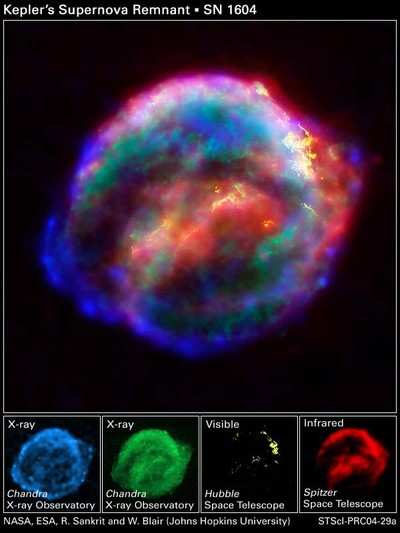Great Observatories May Unravel 400-Year-Old Supernova
Mystery
Four hundred years ago, sky watchers, including the famous
astronomer Johannes Kepler, best known as the discoverer of the
laws of planetary motion, were startled by the sudden appearance of
a "new star" in the western sky, rivaling the brilliance of the
nearby planets.

Modern astronomers, using NASA's three orbiting Great
Observatories, are unraveling the mysteries of the expanding
remains of Kepler's supernova, the last such object seen to explode
in our Milky Way galaxy.
When a new star appeared Oct. 9, 1604, observers could use only
their eyes to study it. The telescope would not be invented for
another four years. A team of modern astronomers has the combined
abilities of NASA's Great Observatories, the Spitzer Space
Telescope, Hubble Space Telescope and Chandra X-ray Observatory, to
analyze the remains in infrared radiation, visible light, and
X-rays. Ravi Sankrit and William Blair of the Johns Hopkins
University in Baltimore lead the team.
The combined image unveils a bubble-shaped shroud of gas and
dust, 14 light-years wide and expanding at 6 million kilometers per
hour (4 million mph). Observations from each telescope highlight
distinct features of the supernova, a fast-moving shell of
iron-rich material, surrounded by an expanding shock wave sweeping
up interstellar gas and dust.
"Multi-wavelength studies are absolutely essential for putting
together a complete picture of how supernova remnants evolve,"
Sankrit said. Sankrit is an associate research scientist, Center
for Astrophysical Sciences at Hopkins and lead for Hubble
astronomer observations.

"For instance, the infrared data are dominated by heated
interstellar dust, while optical and X-ray observations sample
different temperatures of gas," Blair added. Blair is a research
professor, Physics and Astronomy Department at Hopkins and lead
astronomer for Spitzer observations. "A range of observations is
needed to help us understand the complex relationship that exists
among the various components," Blair said.
The explosion of a star is a catastrophic event. The blast rips
the star apart and unleashes a roughly spherical shock wave that
expands outward at more than 35 million kilometers per hour (22
million mph) like an interstellar tsunami. The shock wave spreads
out into surrounding space, sweeping up any tenuous interstellar
gas and dust into an expanding shell. The stellar ejecta from the
explosion initially trail behind the shock wave. It eventually
catches up with the inner edge of the shell and is heated to X-ray
temperatures.
Visible-light images from Hubble's Advanced Camera for Surveys
reveal where the supernova shock wave is slamming into the densest
regions of surrounding gas. The bright glowing knots are dense
clumps that form behind the shock wave. Sankrit and Blair compared
their Hubble observations with those taken with ground-based
telescopes to obtain a more accurate distance to the supernova
remnant of about 13,000 light-years.

The astronomers used Spitzer to probe for material that radiates
in infrared light, which shows heated microscopic dust particles
that have been swept up by the supernova shock wave. Spitzer is
sensitive enough to detect both the densest regions seen by Hubble
and the entire expanding shock wave, a spherical cloud of material.
Instruments on Spitzer also reveal information about the chemical
composition and physical environment of the expanding clouds of gas
and dust ejected into space. This dust is similar to dust which was
part of the cloud of dust and gas that formed the Sun and planets
in our solar system.
The Chandra X-ray data show regions of very hot gas. The hottest
gas, higher-energy X-rays, is located primarily in the regions
directly behind the shock front. These regions also show up in the
Hubble observations and also align with the faint rim of material
seen in the Spitzer data. Cooler X-ray gas, lower-energy X-rays,
resides in a thick interior shell and marks the location of the
material expelled from the exploded star.
There have been six known supernovas in our Milky Way over the
past 1,000 years. Kepler's is the only one for which astronomers do
not know what type of star exploded. By combining information from
all three Great Observatories, astronomers may find the clues they
need. "It's really a situation where the total is greater than the
sum of the parts," Blair said. "When the analysis is complete, we
will be able to answer several questions about this enigmatic
object."
 ANN's Daily Aero-Linx (04.15.24)
ANN's Daily Aero-Linx (04.15.24) Classic Aero-TV: 'No Other Options' -- The Israeli Air Force's Danny Shapira
Classic Aero-TV: 'No Other Options' -- The Israeli Air Force's Danny Shapira Aero-News: Quote of the Day (04.15.24)
Aero-News: Quote of the Day (04.15.24) Airborne 04.16.24: RV Update, Affordable Flying Expo, Diamond Lil
Airborne 04.16.24: RV Update, Affordable Flying Expo, Diamond Lil ANN's Daily Aero-Term (04.16.24): Chart Supplement US
ANN's Daily Aero-Term (04.16.24): Chart Supplement US





